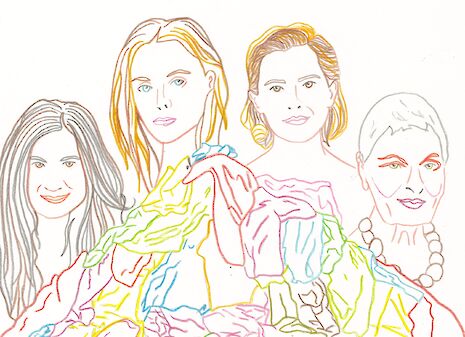The women at the forefront of sustainable fashion
In this week’s column, Caterina Bragoli looks at how female designers, influencers and activists are working to further the sustainable fashion movement

The concept of sustainable fashion has only recently made its way into mainstream media, alerting people to the toxic repercussions of their spending. Attention has been drawn through the pioneering actions of various women who are determined to alter the catastrophic effects of fast fashion by simply advocating the benefits of sustainable production and shopping.
The journey that a garment makes from its point of production to its placement in your wardrobe can often be eye-opening. From toxic waste polluting local water sources, to 8000 litres of water being used to create a single pair of jeans, and the callous deployment of human capital in sweatshops: fashion as an industry can have devastating impacts on the environment, as well as the people whop make our clothing. Counteracting this dangerous sequence of events on the surface seems impossible, as there is so rarely an overlap between global conglomerates cutting costs and also caring about the environment. Yet, with so many women beginning to raise their voices in support for the sustainable fashion cause, the easily-ignored reality is finally being called into question.
Long-established and highly successful female designers are shedding light on the negative impact the world of fashion is truly having, a bold action considering that they are so heavily immersed within that which they are criticising. Take Dame Vivienne Westwood as a fundamental example: the 1990s were defined by Westwood’s new-wave influence on fashion put forward an image of the unapologetically daring and assertive woman. Westwood is known for echoing the sentiments of sustainability in her mantra for consumerism: “Buy less, choose well, make it last”. The simplicity of this statement truly encapsulates the straightforward and seemingly obvious choices that consumers should be making when shopping. Shocking statistics only make Westwood’s words that much more applicable: on average in the UK, a garment has a lifespan of only 3.3 years. The simple adoption of Westwood’s response to this ongoing issue would make a vital difference to the disposability epidemic within the industry, although it must be noted that she has not officially reformed her company to ethical manufacturing standards yet.
Though Westwood may not have contemplated the effect of these words on sales, they certainly promoted a new way of curating your wardrobe – placing longevity at the fore.
Stella McCartney is another female designer paving the way for the future of the industry by making conscious choices in the way in which she designs and manufactures her clothing. McCartney is a priceless voice in support of the sustainable cause, having been awarded an OBE for her services to the industry: she is a pioneer who has a considerable amount of influence in the industry and elsewhere. From the moment she established her self-titled brand in 2001, she refused to use leather or fur on any garment she produced, paying homage to her upbringing on an organic farm.
She received a torrent of hostility towards her industry-altering decision when, 18 years ago, the use of leather and fur was highly coveted. Her ethical decision was seen as a brand-destroying choice, yet she maintained her stance and challenged the established order to become one of the most successful female British designers in recent years. Caring considerably about the entire journey a garment makes, McCartney works with the National Resource Defence Council and the London College of Fashion’s Sustainability Master Course to make the desperately needed difference to the manufacturing process. However, it is undeniable that McCartney’s choices to endorse problematic powerhouses such as Adidas and Target will generate feelings of hypocrisy. Nevertheless the fact that she is making such crucial steps to alter a process that has remained unchanged for decades is paving the way for other brands to follow suit.
Whilst both Westwood and McCartney are long-established names within the industry, room is also being made for rising contributors to the global sustainable fashion movement. One of the leading social entrepreneurs, Safia Minney, has dedicated her career to the promotion of ethical business, especially regarding the fashion industry. Her passionate approach can be seen through her list of achievements: she has established Fair Trade supply chain solutions, launched Global Village in 1995 and started People Tree in London, which is dedicated to selling solely Fair Trade and sustainable fashion.
People Tree was a fundamental forerunner for the development of the sustainable fashion market, with over 200 stores across Europe selling the brand. When a passion like Minney’s for social justice is combined with a love of fashion, the result has the potential to vastly increase the accessibility of sustainability, providing a genuine source of information for people who share her desire to see such change happen.
The culture of celebrity fashion is a chief propeller of the fast fashion movement, with consumers flocking to high-street stores to emulate the wardrobes of celebrities. Unfortunately, the media very rarely reports on stars that feel a sense of responsibility for their influence on fast fashion, rather cultivating a culture of disposable trends through daily red-carpet events or pictures of street style.
However, with celebrities like Emma Watson becoming increasingly affiliated with the sustainable fashion movement, a more ethical message is starting to make its way into mainstream media. Watson has combined her acting career with her role as UN Goodwill Ambassador, pledging to only wear sustainably-produced clothing on red-carpets in an attempt to promote the importance of reduced consumerism. She has previously campaigned with brands such as Alberta Ferretti, Zady, and People Tree, endorsing the work of passionate activists. Through the global attention she receives, Watson’s certifying of the sustainable movement provides an unparalleled force that encourages its longevity.
What each of these very different female pioneers share is a desire to transform an industry that they are extremely passionate about. And fashion is just that: it is something that generates excitement, intrigue and creativity. By taking steps to ensure that the dark, toxic elements of the industry are rectified, the industry can focus on empowering people through clothing. The work of these powerful women across the globe making efforts behind the scenes is finally paving the way for systemic change to come into fruition.
 News / CUP announces funding scheme for under-represented academics19 December 2025
News / CUP announces funding scheme for under-represented academics19 December 2025 News / SU reluctantly registers controversial women’s soc18 December 2025
News / SU reluctantly registers controversial women’s soc18 December 2025 News / Cambridge welcomes UK rejoining the Erasmus scheme20 December 2025
News / Cambridge welcomes UK rejoining the Erasmus scheme20 December 2025 Features / Should I stay or should I go? Cambridge students and alumni reflect on how their memories stay with them15 December 2025
Features / Should I stay or should I go? Cambridge students and alumni reflect on how their memories stay with them15 December 2025 Film & TV / Timothée Chalamet and the era-fication of film marketing21 December 2025
Film & TV / Timothée Chalamet and the era-fication of film marketing21 December 2025










